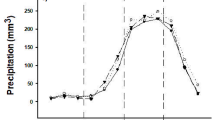Abstract
Many desert lizards show reduced rates of cutaneous water loss (CWL) compared to their counterparts from more humid environments. It is not clear yet whether reduced CWL is connected to the taxonomic position of the lizard studied, or is affected more by environmental or experimental conditions. To investigate this, we measured the skin resistance to water transfer, R s, in five closely related lizard taxa of the genus Agama. These diurnal lizards are distributed in Israel from mesic-Mediterranean to extreme desert biotopes. The highest R s (738 s cm-1) and the lowest CWL (0.160 mg cm-2 h-1) were found in Agama sinaita, which lives in the most arid habitat. The lowest R s (234 s cm-1) and the highest CWL (0.548 mg cm-2 h-1) were found in A. stellio ssp., which occupies mesic habitats. In addition, only the desert species were able to change their R s in accordance with the changing experimental conditions. These R s changes, which probably reflect vasomotor responses, were more pronounced in A. sinaita and presumably enable the desert species to control their CWL in a hot and dry environment.
Similar content being viewed by others
References
Ashkenazi S, Hakham E (1987) Names of the vertebrates in Israel. Nature conservation in Israel, Suppl. 1. Nature Reserves Authority, Jerusalem
Atlas of Israel (1985) Ministry of Labor, Jerusalem, and Elsevier, Amsterdam
Baeyens DA, Rountree RL (1983) A comparative study of evaporative water loss and epidermal permeability in an arboreal snake, Opheodrys aestivus, and a semi-aquatic snake, Nerodia rhombifera. Comp Biochem Physiol 76A: 301–304
Barash A, Hoofien JH (1956) Reptiles of Israel. Hakibutz Hameuchad, Israel
Bentley PJ, Schmidt-Nielsen K (1966) Cutaneous water loss in reptiles. Science 151: 1547–1549
Chew RM, Dammann AE (1961) Evaporative water loss of small vertebrates as measured with an infra-red analyzer. Science 133: 384–385
Claussen DL (1967) Studies of water loss in two species of lizards. Comp Biochem Physiol 20A: 115–130
Cohen AC (1975) Some factors affecting water economy in snakes. Comp Biochem Physiol 51A: 361–368
Dawson WR, Shoemaker VH, Licht P (1966) Evaporative water losses of some small Australian lizards. Ecology 47: 589–594
Dmi'el R (1972) Effect of activity and temperature on metabolism and water loss in snakes. Am J Physiol 223: 510–516
Dmi'el R (1985) Effect of body size and temperature on skin resistance to water loss in a desert snake. J Thermal Biol 10: 145–149
Duvdevani I, Borut A (1974) Oxygen consumption and evaporative water loss in four species of Acanthodactylus (Lacertidae). Copeia 1974: 155–164
Gans C, Krakauer T, Paganelli CV (1968) Water loss in snakes, interspecific and intraspecific variability. Comp Biochem Physiol 27A: 747–761
Hillman S, Gorman GC, Thomas R (1979) Water loss in Anolis lizards: evidence for acclimation and intraspecific differences along a habitat gradient. Comp Biochem Physiol 62A: 491–494
Hertz PE, Arce-Hernandez A, Ramirez-Vazquez J, Tirado-Rivera W, Vazquez-Vives L (1979) Geographical variation of heat sensitivity and water loss rates in the tropical lizard, Anolis gundlachi. Comp Biochem Physiol 62A: 947–953
Kattan GH, Lillywhite HB (1989) Humidity acclimation skin permeability in the lizard Anolis carolinensis. Physiol Zool 62: 593–606
Kobayashi D, Mautz WJ, Nagy KA (1983) Evaporative water loss: humidity acclimation in Anolis carolinensis lizards. Copeia 1983: 701–704
Landmann L (1986) The skin of reptiles: epidermis and dermis. In: Bereiter-Hahn J, Matoltsy AG, Richards KS (eds) Biology of the integument, vol 2. Vertebrates. Springer, Berlin, pp 150–187
Landmann L (1988) The epidermal permeability barrier. Anat Embryol 178: 1–13
Lillywhite HB, Maderson PFA (1982) Skin structure and permeability. In: Gans C, Pough FH (eds) Biology of the Reptilia, vol 12. Academic, New York, pp 397–442
Manes A, Teitelman A (1977) The availability of solar energy at the Eastern Mediterranean. Israel Meteor Res Pap 1: 137–155
Mautz WJ (1980) Factors influencing water loss in lizards. Comp Biochem Physiol 67A: 429–437
Mautz WJ (1982a) Correlation of both respiratory and cutaneous water loss of lizards with habitat aridity. J Comp Physiol 149: 25–30
Mautz WJ (1982b) Patterns of evaporative water loss. In: Gans C, Pough FH (eds) Biology of the Reptilia, vol 12. Academic Press, New York, pp 443–481
McArthur AJ (1981) Thermal insulation and heat loss from animals. In: Clark JA (ed) Environmental aspects of housing for animal production. Butterworths, London, pp 37–60
Minnich JE (1970) Evaporative water loss from the desert iguana Dipsosaurus dorsalis. Copeia 1970: 575–578
Monteith JL (1973) Principles of Environment Physics. Arnold, London
Monteith JL, Campbell GS (1980) Diffusion of water vapour through integuments — potential confusion. J Thermal Biol 5: 7–9
Roberts LA (1968) Water loss in the desert lizard Uta stansburiana. Comp Biochem Physiol 27A: 583–589
Roberts JB, Lillywhite HB (1980) Lipid barrier to water exchange in reptile epidermis. Science 207: 1077–1079
Roberts JB, Lillywhite HB (1983) Lipid and permeability of epidermis of snakes. J Exp Zool 228: 1–9
Robertson SL, Smith EN (1982) Evaporative water loss in the spiny soft-shelled turtle Trionyx spiniferus. Physiol Zool 55: 124–129
Schmidt-Nielsen K (1964) Desert animals. Physiological problems of heat and water. Oxford University Press, London
Sokal RR, Rohlf FJ (1969) Biometry. WH Freeman & Co, San Francisco, p 776
Spotila JR, Berman EN (1976) Determination of skin resistance and the role of skin in controlling water loss in amphibians and reptiles. Comp Biochem Physiol 55A: 407–411
Spotila JR, Weinheimer CJ, Paganelli CV (1981) Shell resistance and evaporative water loss from bird eggs: effect of wind speed and egg size. Physiol Zool 54: 195–202
Thorpe GS, Kontogiannis JE (1977) Evaporative water loss in isolated populations of the coastal side-blotched lizard, Uta stansburiana hesperis. Comp Biochem Physiol 57A: 133–137
Tracy CR, Sotherland PR (1979) Boundary layers of bird eggs: do they ever constitute a significant barrier to water loss? Physiol Zool 52: 63–66
Warburg MR (1966) On the water economy of several Australian geckos, agamids, and skinks. Copeia 1966: 230–235
Author information
Authors and Affiliations
Rights and permissions
About this article
Cite this article
Eynan, M., Dmi'el, R. Skin resistance to water loss in agamid lizards. Oecologia 95, 290–294 (1993). https://doi.org/10.1007/BF00323502
Received:
Accepted:
Issue Date:
DOI: https://doi.org/10.1007/BF00323502




